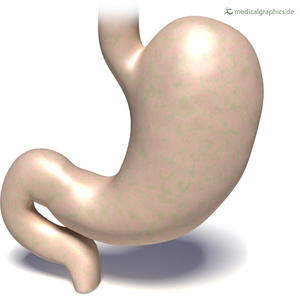Stomach
Contents
Key Stage 1
Meaning
The stomach is a part of the body where our food goes when we eat it.
Key Stage 2
Meaning
The stomach is a part of the digestive system and digest our food.
Key Stage 3
Meaning

A computer image of the stomach.
The stomach is an organ in the digestive system which breaks down food molecules into small molecules using enzymes.
Adaptations of the Stomach
- The stomach produces Hydrochloric Acid.
- The Hydrochloric Acid in the stomach kills bacteria to help prevent us getting sick.
- The stomach digests food using enzymes.
- The enzymes in the stomach work best in acid.
- The stomach has a layer of mucus covering it to prevent digestive juices from damaging the lining of the stomach.
Key Stage 4
Meaning
The stomach is an organ in the digestive system which breaks down food molecules into small molecules using enzymes.
About the Stomach
- The stomach produces Hydrochloric Acid.
- The stomach digests food using digestive enzymes including a protease called pepsin which breaks down proteins into amino acids.
- The Hydrochloric Acid in the stomach kills bacteria to help prevent infection and keeps the stomach acidic to be the optimum pH for the Digestive Enzymes to work.
- The protease pepsin is an enzyme found in the stomach which has an optimum pH of 1.6.
References
AQA
- Stomach, page 31, GCSE Biology; The Revision Guide, CGP, AQA
- Stomach, pages 100, 103, 148, GCSE Biology; Student Book, Collins, AQA
- Stomach, pages 37-39, 48, GCSE Biology; Third Edition, Oxford University Press, AQA
- Stomach, pages 44, 47, GCSE Combined Science Trilogy 1, Hodder, AQA
- Stomach; acid production, page 85, GCSE Combined Science Trilogy 1, Hodder, AQA